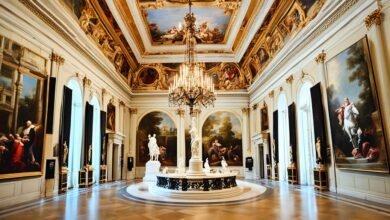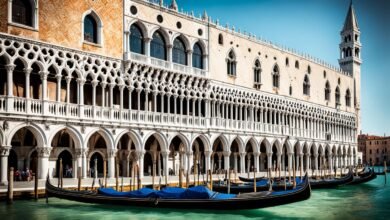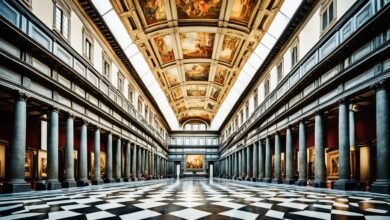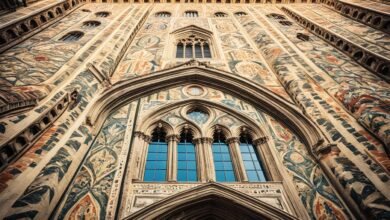Table of Contents
Villa d’Este in Tivoli, Italy, is more than a UNESCO site. It’s a key symbol of the Italian Renaissance. This stunning villa draws art and history lovers globally with its marvelous architecture and gardens.
Commissioned by Cardinal Ippolito II d’Este, the villa was built by architect Pirro Logorio. It took 20 years to complete this masterpiece, covering 4 hectares. It features a palace, lined avenues, and more than a hundred splendid fountains, showcasing true Italian Renaissance art.
At Villa d’Este, you step back in time and discover its architectural beauty and history. The charm of its historical gardens brings the past to life for visitors.
The History of Villa d’Este
Villa d’Este dates back to the Renaissance period. It was commissioned by Cardinal Ippolito II d’Este to showcase his wealth and artistic taste. The villa’s construction started in 1550 and took about 20 years to complete. Architect Pirro Logorio made the cardinal’s dream a reality.
Villa d’Este faced many challenges during its building phase. However, it emerged as a stunning example of Renaissance architecture. It’s a symbol of Cardinal Ippolito II d’Este’s influence and creativity. Today, Villa d’Este is a UNESCO World Heritage site of great historical importance.
The Vision of Cardinal Ippolito II d’Este
Cardinal Ippolito II d’Este aimed to display his opulence and refined tastes with Villa d’Este. He wanted it to be a symbol of his wealth and power. The villa’s design blends elegance with grandeur, highlighting the era’s architectural achievements.
Architectural Marvel by Pirro Logorio
Architect Pirro Logorio was crucial in realizing Cardinal Ippolito II d’Este’s vision. His mastery of Renaissance architecture is evident in Villa d’Este’s design. Logorio’s meticulous work can be seen in the villa’s detailed exterior and interior.
A UNESCO World Heritage Site
Villa d’Este is a UNESCO World Heritage site for its historical and architectural value. It’s a cultural treasure from the Renaissance era. The villa’s grandeur and history attract visitors worldwide.
The Splendor of the Gardens
Villa d’Este’s gardens are well-known for their beauty. They are a prime example of Renaissance garden design in Europe. The gardens cover a large area and are lined with trees and hedges. This makes the place serene and enchanting. It all invites visitors to dig into the beauty of nature.
The main attraction is the many fountains. There are over a hundred, each like a masterpiece. They show off the skill of Renaissance garden makers and designers. The fountains prove how creative and clever the people who made them were. Their water displays are amazing and leave visitors stunned.
The water elements are seamlessly part of the gardens. This includes waterfalls and playful jets. The fountains add to the gardens’ beauty and peace, making the villa even more stunning.
Walking through the gardens is a harmonious mix of art, nature, and human skill. The paths are carefully laid out, leading to treasures like the fountains. It’s a chance for visitors to experience the calm and beauty the Renaissance aimed for.

Embracing Renaissance Garden Design
Villa d’Este’s gardens show the essence of Renaissance style. They have balanced, neat designs and lots of detail, characteristic of that time. The gardens perfectly balance nature and human touch. This creates a beautiful and engaging atmosphere.
The Renaissance wanted to blend human-made with natural beauty. Villa d’Este’s gardens are a great example of this idea. They are filled with carefully planned areas that delight the senses.
Exploring the Fountains of Villa d’Este
The fountains of Villa d’Este are more than just for looks; they are artworks. Each fountain is special and shows the amazing skill of the Renaissance. For example, there’s the Fountain of the Bicchierone and the fun Water Organ Fountain. Every fountain at Villa d’Este has its own unique appeal.
The Fountain of Neptune is one of the most famous. It stands in the garden’s heart, impressing all who see it. Everywhere in Villa d’Este, the fountains reflect the Renaissance’s artistic and architectural mastery.
A Tranquil Haven
With stunning fountains and lush greenery, Villa d’Este is peaceful. It’s a quiet place around the magnificent villa. Visitors can wander, find peaceful spots, and enjoy the tranquility that has charmed people for ages.
Everything, from the tidy hedges to the bright flowers, offers a unique experience. Villa d’Este’s gardens let visitors step into a world of beauty and history. The garden leaves a lasting memory that lasts long after the visit.
Notable Fountains at Villa d’Este
Villa d’Este is well-known for its amazing fountains that make its gardens stunning. Each fountain shows off beautiful craft and design. Here are some of the most famous fountains at the Villa d’Este.
Fountain of Neptune
The Fountain of Neptune is a key place for photos and a top fountain at Villa d’Este. It has a big sculpture of Neptune, with dolphins and tritons around him. The beauty and detail of this fountain are a highlight on any tour.
Rometta Fountain
The Rometta Fountain pays homage to Rome’s greatness. It features a sculpture of a seated Rome, with figures of rivers and mountains around. This fountain reminds us of Rome’s ancient power and the history of Villa d’Este.
Fontana dell’Ovata
The Fontana dell’Ovata stands out on the Viale delle Cento Fontane. Its oval shape and gentle water flow make it a calm and inviting place. It’s a spot where visitors often pause to enjoy its appearance.
Fontana del Bicchierone
The Fontana del Bicchierone is a masterpiece by Gian Lorenzo Bernini, a famous Baroque artist. It shows a chalice in a shell, signifying a full life. The details and skill shown in this fountain are very captivating.
Villa d’Este’s fountains, including these, are a joy to see. Their art and water shows create a magical feeling. As you stroll through the gardens, don’t miss the chance to stop and look at these beautiful fountains.
Exploring the Palazzo d’Este
The Palazzo d’Este is a beautiful palace at Villa d’Este. It shows the amazing architecture and luxury of the Renaissance.
Its elegant façade grabs your attention from the start. A grand loggia welcomes you, leading into a hall that hints at the grandness within.
Step inside, and you’re surrounded by stunning art. The Appartamento Nobile’s frescoes highlight the Renaissance’s artistic pinnacle. These paintings tell old stories and share the period’s ideas.
Don’t miss the Appartamento Vecchio and Sala delle Storie di Salomone. These rooms show how wealthy people lived in the Renaissance. They’re filled with frescoes that reflect the rich culture and art of that time.
Appartamento Nobile
The Appartamento Nobile is a set of rooms for noble residents. They’re filled with incredible frescoes showing myth, history, and religion. Each artwork is a detailed story in itself.
Appartamento Vecchio and Sala delle Storie di Salomone
The Appartamento Vecchio and Sala delle Storie di Salomone are special spots in the Palazzo d’Este. They reveal the wealth and love for art of the previous residents. The wall frescoes are a sign of the Renaissance’s exceptional talent.
Going through Palazzo d’Este takes you to the world of Renaissance nobles. Its art and design are windows to that era’s culture and creativity.
Practical Information for Visiting Villa d’Este
Thinking of going to Villa d’Este? Get ready with these helpful tips.
Tickets and Pricing
Buying a ticket allows you into Villa d’Este. Tickets are sold there. The regular entry fee is 8.00. Reduced tickets cost 4.00 for some guests.
If you want to join special events, you can buy a 11.00 ticket. This is a great way to see more of the villa and its gardens.
Opening Hours
Villa d’Este’s hours change with the seasons. During summer (April to September), it’s open from 8:30 AM to 7:30 PM. In winter (October to March), the hours are 8:30 AM to 5:30 PM. Always check before you go as hours may change.
Contact Information
To find out more or reserve your tickets, call +39 0774 312070. You can also check their website at www.villadestetivoli.info for details and tickets.
Villa d’Este is not just a beautiful place. It’s a UNESCO site. When you visit, you’ll see great history and amazing architecture.
| Ticket Type | Price () |
|---|---|
| Standard Ticket | 8.00 |
| Reducated Ticket | 4.00 |
| Ticket with Events | 11.00 |
Recommended Time and Tips for Visiting Villa d’Este
When planning your visit to Villa d’Este, the time you go matters. The spring and early summer are perfect, from April to June. The weather is nice, and the gardens look their best. This makes the villa even more stunning to visit.
Go in the morning or late afternoon for a better time. You’ll avoid the bigger crowds and have the villa more to yourself. This also means you can take great photos without too many people around.
Consider joining a Tivoli Villa d’Este tour for a deep dive into its history. You’ll learn a lot about the villa’s past, architecture, and garden meanings. Guides will share fascinating stories about this UNESCO site.
| Tips for Visiting Villa d’Este: |
|---|
| 1. Plan ahead: Check the opening hours and ticket availability before your visit to ensure a smooth experience. |
| 2. Wear comfortable shoes: The villa and its gardens require some walking, so it’s essential to wear comfortable footwear for a pleasant exploration. |
| 3. Bring a camera: Villa d’Este offers countless photo opportunities, so don’t forget to bring your camera to capture the stunning sights and intricate details. |

To truly enjoy Villa d’Este, visit during the best times and take a tour. Follow our tips for a memorable trip. This way, you’ll make the most of your visit to this historic gem.
Nearby Attractions to Explore
During your Tivoli day trip, explore sites that add to your visit to Villa d’Este. These spots offer historical and natural beauty. They make your trip more enriching and enjoyable.
Villa Adriana
Villa Adriana, also called Hadrian’s Villa, is a UNESCO site. It shows off the Roman Empire’s elegance. This villa was a lavish escape for Emperor Hadrian. Admire its awe-inspiring architecture and think about life in ancient Rome.
Villa Gregoriana
Villa Gregoriana is not only a park but also a peaceful spot. This park, taken care of by the FAI, has lush forests and a stunning waterfall. Walking there means diving into a sea of calmness and enjoying the amazing views.
Temple of Vesta
The Temple of Vesta sits in Tivoli’s old acropolis. It’s a key ancient site for the goddess of the hearth. The temple is unique with its circular shape and columns in the Roman style. Discover the ruins and imagine the religious events that occurred there.
These sites will add to your experience at Villa d’Este. They offer a mix of history and natural beauty. So, enjoy your Tivoli day trip to the fullest.
Where to Stay and Dine in Tivoli
In Tivoli, there are many places to stay that fit different budgets and tastes. Whether you want luxury or somewhere affordable, you’ll find great choices here. Places like Hotel Torre Sant’Angelo, The Gran Melia, or Villa Grazioli Hotel offer luxury and comfort. For those looking for budget options, places like Hotel Cristallo Relais or Hotel Victoria Terme are welcoming.
When talking about food, Tivoli is a dream for everyone. You can enjoy the tastes of Italy or try international dishes. Cuda Navis, Antognolla, and Il Cardinale are a few places known for their tasty food. These meals are perfect after visiting Villa d’Este and its beautiful scenery.
No matter where you decide to stay, Tivoli ensures you have a great time. There’s a lot of food to try, adding to your experience of the city. Have a wonderful time in Tivoli and make great memories exploring Villa d’Este and the area.”




